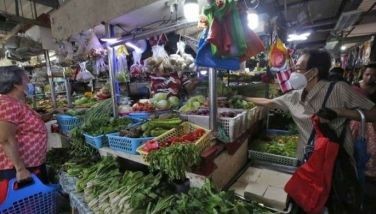A growing appetite for corn

Over the last two decades, domestic consumption of corn more than doubled, which an ordinary Filipino could find puzzling since his daily source of carbohydrates comes basically from rice, and partially supplemented by bread.
According to the US Department of Agriculture, the Philippines consumed 9.2 million metric tons of corn last year, a big jump from consumption in 2002 of 4.65 MMT. Where did this go?
Like the rest of Asia, Filipinos have found gustatory pleasure in foods on the dining table other than the rice, fish, and vegetables that our grandparents preferred. Among the new additions to the food basket of an ordinary family are chicken and pork, and occasionally beef.
Such new diet preferences explains the growth of our livestock and poultry sectors, both of which have been buoyed by a remarkable rise in the household food spending on pork, chicken, and eggs. No meal is now complete without the protein supplied by these products.
For our livestock and poultry growers to keep up with demand pressures, including a fast-growing population that has increased from only 81 million in 2002 to the current 115 million, swill or leftover foods for pigs and palay for chicken had to be replaced by an improved diet that guaranteed faster growth.
Yes, corn in feeds became the new go-to for growers. A high percentage of corn in the mash guaranteed better results: chickens were harvested at shorter time cycles, egg production was improved, and pigs grew fatter with less risks of being infected by deadly diseases.
Food security
The Philippines is not unique among developing and newly developed economies in Asia in seeing this increased appetite for pork and chicken. Vietnam, which has a population slightly under100 million, consumes about the same equivalent amount of chicken that our country does.
China, with a population of 1.4 billion, had a consumption of chicken and swine meats of 14.4 MMT and 52.7 MMT, respectively, last year, dwarfing the Philippines’ consumption of chicken and pork at 1.7 MMT and 1.5 MMT, respectively.
Such a huge demand for livestock and poultry in the world’s most populated economy currently had moved its government to push for a corn growing program that ensured a self-sufficiency ratio of well-above 95 percent. In fact, China harvests more corn than rice, making it the second biggest producer in the world next only to the United States.
The context of China’s interest in increasing its own corn supplies, even going on binge-buying sprees from other corn exporting countries during the pandemic years when it forecasted low reserves, lies in a desire to achieve a high level of food security.
The Philippines too has highlighted the need for food security, although sometimes it feels like this avowal is more in line with a growing global trend rather than a real commitment to ensure stable sources of food at prices that are not at the mercy of global supply and demand caprices.
Increased food import substitution
Hence, we continue to see a vague push to improve agricultural productivity, and a growing attraction towards import substitution with products like pork, beef, some chicken products, and corn often priced lower in the world market in spite of tariff barriers.
Local food producers never tire protesting when government moves to lower tariffs or authorizes increased emergency importation volumes in response to domestic supply or pricing instability. We saw this when pork farms were plagued by the African swine fever, when local rice production was severely affected by typhoons, and when fish harvests were markedly lower because of seasonal changes. We’re seeing this with the reported shortage in onions.
Often, tinkering with tariffs is a temporary prerogative of government. When normal supply and prices are restored, tariffs are raised again. Unfortunately, we’re seeing these interventions more often now that food inflation has gone haywire.
It’s not a choice that our economic team willingly recommends, especially at this time when the government needs every centavo it can lay its hands on to finance the state budget, which has been increasing by leaps and bounds in recent years.
Reduced tariffs, even if they are time-bound, represents lowered government revenues, although often, the economic team grudgingly foregoes such levy collections in favor of keeping the cost of imported commodities from contributing to inflation.
Comprehensive program
Protests by affected stakeholders on reduced tariffs are often short-lived, usually because supply and demand issues are soon resolved. In the current administration’s short list of inflation-busting interventions, however, the temporary reduction in tariff on corn from a high of 50 percent to 15 percent until yearend 2023 deserves a more serious review.
Corn, which can go up to as high as 60 percent in feeds for chicken and pigs, is very much a cause for food inflation, especially since almost half of the corn requirements of the livestock and poultry industry is imported.
Like China, the Philippines needs to realize the importance of improving local corn self-sufficiency to levels of at least 95 percent to enable the livestock and poultry industry to bring down their production costs. Our pork and chicken prices are still one of the highest in the region even with reduced tariffs.
An environment of increased corn harvests will not happen if we keep our local farming in the dark ages, persisting in growing in small land parcels that prevent utilization of modern technologies. A review of the most recent livestock and poultry development bill filed in Congress needs more thinking if we are truly intent on doubling corn harvest in the next few years.
Facebook and Twitter
We are actively using two social networking websites to reach out more often and even interact with and engage our readers, friends and colleagues in the various areas of interest that I tackle in my column. Please like us on www.facebook.com/ReyGamboa and follow us on www.twitter.com/ReyGamboa.
Should you wish to share any insights, write me at Link Edge, 25th Floor, 139 Corporate Center, Valero Street, Salcedo Village, 1227 Makati City. Or e-mail me at [email protected]. For a compilation of previous articles, visit www.BizlinksPhilippines.net.
- Latest
- Trending




























